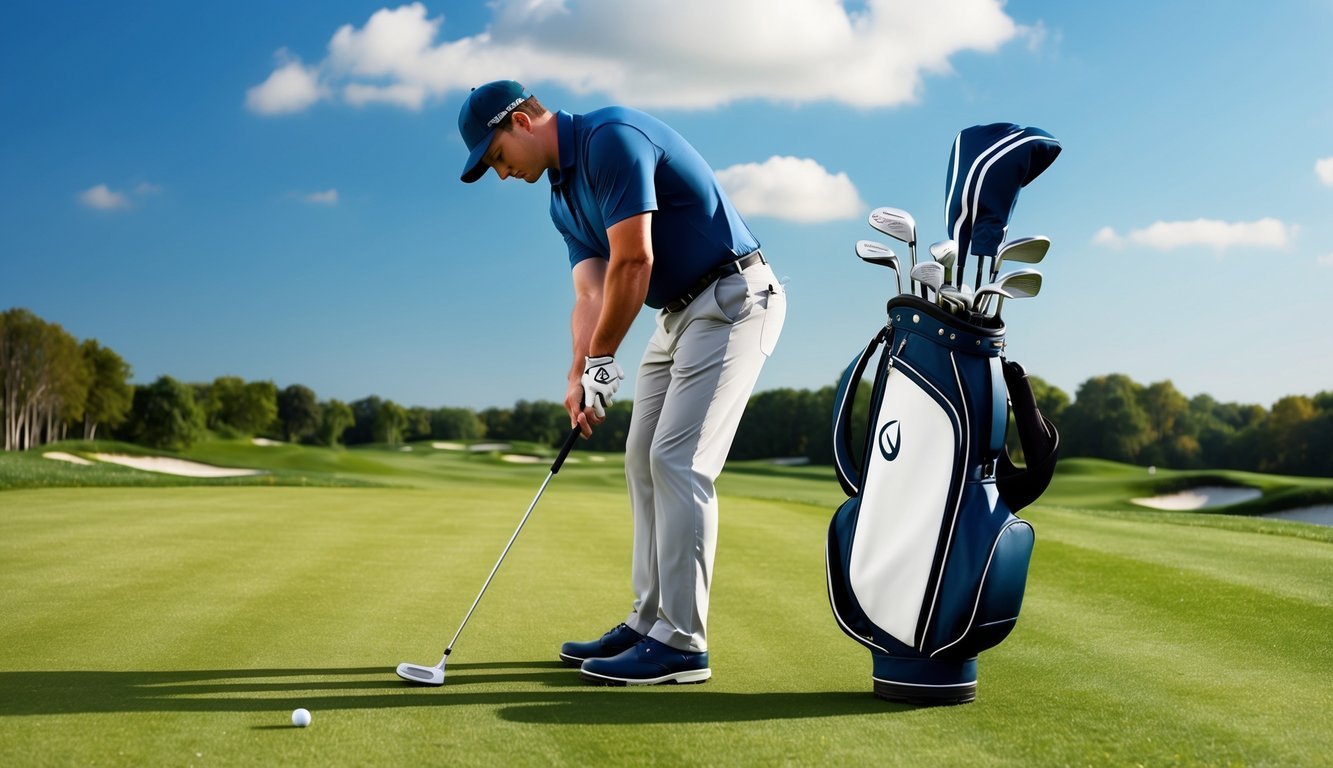Choosing the right golf club can make all the difference in your game, especially when deciding between a 7 wood and a 4 hybrid.
Each offers distinct advantages tailored to different play styles.
The 7 wood is known for its ability to provide significant distance and power, while the 4 hybrid excels in offering control and precision.
Understanding these differences can help you select the club that aligns with your strengths and the conditions of the course.

If you’re grappling with which club to add to your bag, consider your priorities on the green.
A 7 wood can be your ally if you seek to maximize distance, particularly for long shots.
On the other hand, the 4 hybrid can prove invaluable when tackling challenging rough patches or when you require precise, accurate shots.
Consider the course and terrain you play on most often.
If your game frequently involves wide open fairways, a 7 wood might give you the reach you need.
Conversely, if your rounds often involve tricky lies or obstacles, a 4 hybrid offers the versatility and ease of use that could complement your style.
Key Takeaways
- 7 wood and 4 hybrid cater to different playing styles and needs.
- 7 wood provides more distance, while the 4 hybrid offers better control.
- Terrain and personal playing style are crucial to club selection.
Understanding the Basics
In the world of golf, choosing between a 7 wood and a 4 hybrid can significantly impact your game.
Delve into the essentials of these clubs, including their roles in your golf bag and their unique characteristics, to make an informed choice.
The Role of Clubs in a Golf Bag
Every golf bag typically carries up to 14 clubs, and each club has its own purpose.
Woods and hybrids are essential for longer shots, complementing irons and fairway woods to give you versatility.
Woods usually offer long-distance capabilities useful off the tee or for long fairway shots.
Hybrids are designed to bridge the gap between woods and irons, providing control and aiding in situations where precision is important.
Having a proper mix of clubs like a 7 wood or a 4 hybrid ensures you are prepared for various course challenges.
It’s crucial to select clubs that not only match your skill level but also align with the specific demands of the courses you frequent.
Specifics of a 7 Wood
A 7 wood is designed with a larger clubhead and a higher loft, typically between 20 to 23 degrees.
This club is ideal for golfers seeking distance, as its longer shaft and clubhead speed allow shots to reach up to 210 yards for some players.
The 7 wood also excels in situations requiring shots from fairways or light rough, where its design helps lift the ball into the air easily.
Many golfers use a 7 wood as a substitute for a driver on courses with narrow fairways due to its forgiving nature.
For those looking to add distance to their game while maintaining a degree of forgiveness, the 7 wood stands as a valuable addition to the golf bag.
Characteristics of a 4 Hybrid
The 4 hybrid blends the attributes of woods and irons, offering versatility and control.
With a loft angle similar to the 7 wood, the 4 hybrid generally allows for more manageable shots, typically reaching between 160 to 200 yards.
Control and accuracy are the primary benefits of a 4 hybrid, making it ideal for approaches or when navigating tight fairways.
Its design allows for a smoother swing and improved contact, especially beneficial for those who struggle to hit long irons consistently.
Choosing a 4 hybrid can enhance shot accuracy and provide confidence when dealing with challenging lies or needing precision placement on the golf course.
Technical Comparison
When comparing a 7 wood and a 4 hybrid, it’s essential to examine their technical attributes.
These include differences in loft and launch angles, which affect the club’s performance, as well as factors like distance, accuracy, spin, and ball flight characteristics.
Loft and Launch Angles
The loft angle plays a significant role in determining the launch of your golf shots.
With a typical range of 20-23 degrees, a 7 wood generally offers a slightly higher loft than a 4 hybrid.
This means the 7 wood can facilitate higher launches, which might be beneficial if you want to clear obstacles or land softly on the green.
A 4 hybrid, on the other hand, provides a unique combination of wood and iron characteristics, allowing you to maintain a lower trajectory and giving you more control in windy conditions.
These differences are crucial when deciding which club better suits your gameplay and course conditions.
Distance and Accuracy
Distance and accuracy are critical when evaluating these clubs.
A 7 wood usually delivers longer shots, with average distances ranging from 170 to 210 yards.
Its longer shaft and optimized clubhead weight boost speed, thus increasing distance potential.
Conversely, a 4 hybrid generally travels 10 yards less than a 7 wood, often covering 160 to 200 yards.
Despite shorter distances, the hybrid’s design offers better accuracy, especially beneficial for reaching specific spots on the course. Golf Sidekick’s insights on loft and distance can provide additional perspectives on these factors.
Spin and Ball Flight
The spin and ball flight characteristics of a golf club affect your control over the shot.
A 7 wood tends to impart more backspin due to its higher loft, which can be advantageous for stopping the ball quickly upon landing.
The increased backspin also contributes to its tendency for a higher ball flight.
In contrast, the 4 hybrid balances spin and flight by combining features of irons and woods.
This combination results in a versatile club that offers both decent spin control and adaptable ball flight.
Depending on your playing style and the course conditions you face, each club’s spin and flight attributes might sway your choice.
Practical Considerations

When deciding between a 7 wood and a 4 hybrid, understanding how each fits into your game is important.
Key factors include course management strategies and swing mechanics, which can influence which club might be the best fit for various scenarios.
Course Management Strategies
Selecting the right club impacts how you manage different areas like fairways and the rough.
The 7 wood, with its larger clubhead, offers increased forgiveness on mishits, making it useful if you’re a golfer who often finds yourself in difficult lies.
On the other hand, the 4 hybrid is known for its versatility, ideal on par 3s or tight fairways.
Assessing the typical course you play helps in determining which club may offer more opportunities for improved scoring.
Consider your handicap too, as lower handicappers may value control over distance.
Swing Mechanics and Club Selection
Your swing mechanics can greatly impact whether a 7 wood or a 4 hybrid suits your play style.
The 7 wood tends to favor a golfer with a sweeping motion, providing a higher launch due to the club’s loft and longer shaft, leading to increased swing speed and distance.
Conversely, a 4 hybrid is typically designed for a steeper swing plane.
It helps when you need to strike the ball cleanly off the fairway or from the rough.
Focus on which swing feels more natural and delivers better results during practice sessions.
Understanding where each club excels helps in making an informed decision.
Performance and Suitability

Choosing the right golf club can significantly impact your game, whether you’re a professional or a weekend enthusiast.
Understanding the nuances between a 7 wood and a 4 hybrid can help boost your performance and cater to your specific needs on the course.
Adapting to Player Skill Levels
Different clubs offer distinct advantages based on skill level.
As a high handicapper, you might find the 7 wood advantageous due to its greater forgiveness and ease of use.
Its ability to elevate the ball quickly can also be a blessing when dealing with challenging lies.
More experienced golfers may prefer the 4 hybrid, as it offers a blend of wood and iron characteristics that provide adaptability across various shots.
Mid to long irons can be tricky, but a hybrid can bridge that gap by offering precision and control.
This allows you to maintain accuracy even in less-than-ideal conditions.
Exploring these options based on your ability can enhance your game, making it more enjoyable and rewarding.
Tour Player Preferences vs. Amateur Choices
On the PGA Tour, players like Dustin Johnson often lean towards hybrids due to their versatility and the ability to shape shots.
For professional golfers, the priority is optimizing performance, and the 4 hybrid offers a balance between distance and control.
Amateurs, on the other hand, might benefit from the straightforward distance and higher launch provided by a 7 wood.
Amateurs often look for easier pathways to consistency, making the forgiving nature of a wood appealing.
Considering what professionals use can inspire your choices, but the most suitable option often boils down to what feels comfortable and effective for you on the course.
Advanced Insights

When considering a 7 wood or 4 hybrid, it’s crucial to understand how their construction impacts performance.
You’ll also want to explore how these clubs represent evolution in golf equipment design.
Manufacturing Differences
Understanding the construction of golf clubs can enhance your game.
The club head of a 7 wood is typically larger, offering a higher center of gravity, which aids in launching the ball with a higher trajectory.
This feature makes it suited for players looking to maximize distance.
On the other hand, the 4 hybrid boasts a compact club head, often aiding in improved accuracy.
The choice between a graphite and steel shaft influences flexibility, weight, and overall feel. Graphite shafts are generally lighter, providing more swing speed and increased distance.
They are ideal if you’re seeking less vibration on impact.
Meanwhile, steel shafts offer better control and feedback, perfect if you prioritize precision.
The grip is another element that can vary, with different materials affecting comfort and performance.
These differences provided by various manufacturers form the basis for these clubs’ capabilities.
The Evolution of Golf Clubs Over Time
Golf clubs have evolved greatly, affecting how you approach your game.
A key development has been in the materials used for shafts and club heads.
More lightweight materials like graphite have permitted golfers to achieve greater swing speeds.
Consequently, they can also achieve greater distances.
The introduction of hybrid clubs, such as the 4 hybrid, reflects the demand for equipment that combines the best features of irons and woods.
These advancements allow golfers more versatility, accommodating various conditions and lies.
You can also notice changes in club head design, with modern clubs providing optimized aerodynamics and adjustability.
These features help you tailor the club to suit your playing style and course challenges.

